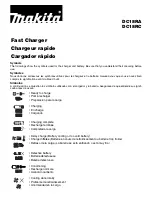
20
ENGLISH
EN
Residual Risk
Even when the device is used properly and all safety
regulations are complied with, there still may be
some residual risks.
WARNING !
Wear eye protective goggles ! Wear gloves!
Keep childrenaway from acids and filled
batteries.
Corrosion Hazard !
Battery acid is highly caustic.
First Aid
Rinse out any acid splashed into the eyes
immediately using clear water for several
minutes. Consult a doctor immediately.
Neutralise acid splashes on skin or clothes
immediately using acid neutraliser or soap
suds and rinse with plenty of water.
If acid is consumed, consult a doctor
immediately.
Emergency procedure
Conduct a first-aid procedure adequate to the injury
and summon qualified medical attendance as quickly
as possible. Protect the injured person from further
harm and calm them down. If you seek help, state the
following pieces of information:: 1. Accident site, 2.
Accident type, 3. Number of injured persons, 4. Injury
type(s)
Mains Connection
Operation is only allowed with a safety switch
against stray current (RCD max. stray current of
30mA).
Before putting into operation, a qualified electrician
must check whether electric safety measures required
are in place. Any national regulations in this regard
must be complied with.
Electric connection to a socket.
It is necessary to make sure the connecting socket
was not near water and humidity and the plug was
protected against humidity.
Check the voltage. Technical data given on the type
label must correspond with electric network voltage.
Only use splash proof extension cables approved for
outdoor purposes.
Check the cable and/or socket for damages before
the appliance putting into operation.
Never use the charger when the cable, plug or the
machine is damaged by external influences. In case
damage let repaired in authorized workshop
Ensure that the vehicle is switched off if the battery is
mounted fixed in the vehicle! Switch off the ignition.
Park the vehicle and secure it.
1. First connect the red battery clip to the positive
terminal of the battery.
2. Then connect the black battery clip with the nega-
tive terminal of the battery (Mounted in the chassis,
away from the battery and fuel line).
3. Plug the charger into a mains socket.
4. After charging: Disconnect the charger from the
mains socket.
5. First remove the black clip from the chassis and
then the red clip from the battery.
This sequence must be followed!
Danger of short circuit! Make sure that the two clips
of the pole connecting cables do not touch or are
connected by a conductive object, such as a tool.
Handle the terminal connecting cable (“–” and “+”)
only by the insulated sections!
Never hold both clips at the same time when the
device is running.
Specified Conditions of Use
The battery charger is only to be used for charging
and starting of vehicles taking all technical data into
consideration.
Types of batteries:
- Lead acid batteries (liquid electrolyte) (PB)
- Gel battery (GEL)
- Absorbent glass mat battery (AGM)
- Wet-cell batteries (WET)
- Maintenance-free lead acid batteries (MF)
WARNING
It is not suitable for charging Li-ion, NiCad or NiMH
batteries and other non-rechargeable batteries, for
example.
Please note that our equipment has not been
designed for commercial, craft or industrial use. If the
equipment is used in commercial, craft or industrial
operation or for similar activities, we cannot assume
any liability.
Do not use this product in any other way as stated
for normal use. Not observing general regulations
in force and instructions from this manual does not
make the manufacturer liable for damages.
















































